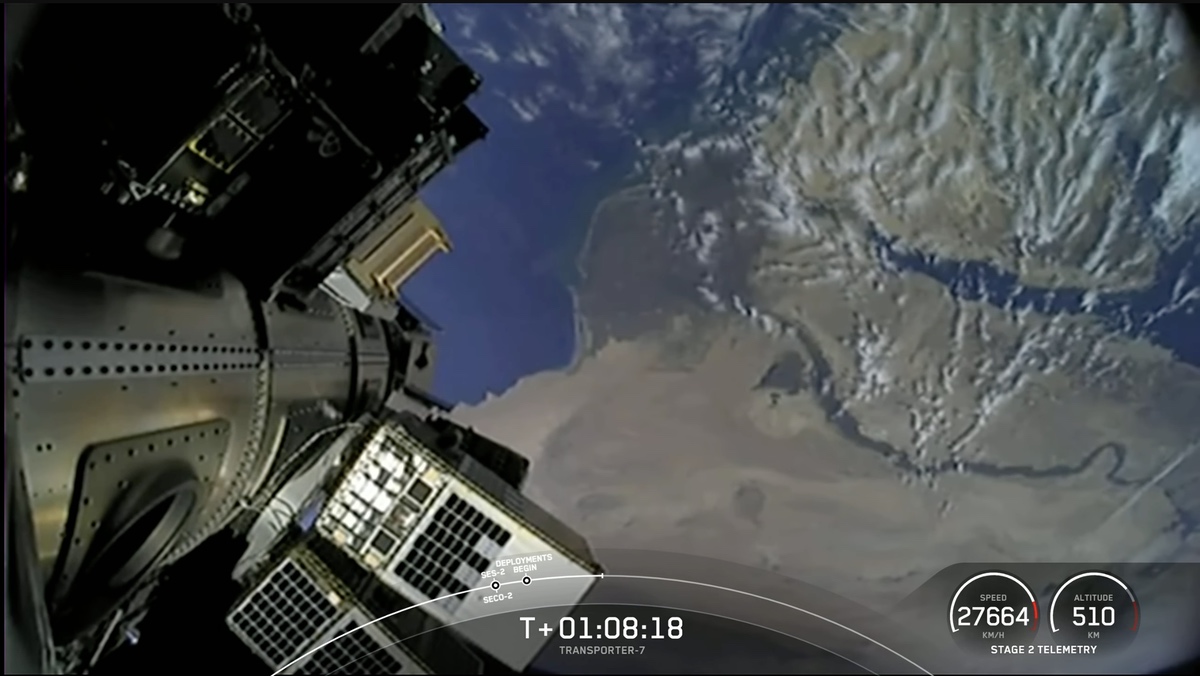WASHINGTON — SpaceX launched more than 50 satellites early April 15 on the latest in a series of dedicated Falcon 9 smallsat rideshare missions.
The Falcon 9 lifted off from Vandenberg Space Force Base in California on the Transporter-7 mission at 2:48 a.m. Eastern, after several days of weather-related delays. The upper stage reached orbit a little more than eight minutes later, shortly after the first stage landed back at the launch site.
Most of the payloads were deployed starting an hour after liftoff, following a second burn of the upper stage. Those payloads were released over a span of about 20 minutes. The upper stage then performed two more maneuvers before deploying the final, and largest, payload, the 800-kilogram IMECE imaging satellite built by Turkish research institute Tübitak Uzay 2 hours and 35 minutes after liftoff.
This launch, the 23rd Falcon 9 mission of the year, did have some novelties. It was the first Falcon 9 launch to use a shorter nozzle on the rocket’s upper-stage engine. Company representatives said on the launch webcast that they will use the shorter nozzle, which saves money, on launches that do not need as much performance, but retain the longer nozzle for higher-performance missions.
That affected the landing of the booster. Falcon 9 missions have previously used three engines on its entry burn and a single engine for landing. On this flight, though, the booster reversed that, firing a single engine for the entry burn but three for landing, an approach SpaceX has previously used for landings of Falcon Heavy side boosters but not for the Falcon 9.
The launch carried 51 payloads, SpaceX said, although it did not release a full list of the satellites on board. This was the first in SpaceX’s series of Transporter dedicated smallsat rideshare missions to launch from Vandenberg, after the first six launched from Cape Canaveral, Florida.
Several companies used the launch to augment existing constellations of satellites. Satellogic had four imaging satellites onboard while GHGSat had three satellites for greenhouse gas monitoring. HawkEye 360 launched its seventh cluster of three satellites for radiofrequency (RF) monitoring and Unseenlabs launched its BRO-9 satellite, also for RF monitoring. Umbra launched another synthetic aperture radar imaging satellite.
Spire had three satellites on the launch, but only one was for its own network for collecting weather, maritime and aviation tracking data. Two others were from its space services business: one for Saudi Arabia’s King Abdullah University of Science and Technology equipped with a hyperspectral camera and a sensor for measuring soil moisture, while the ADLER-2 satellite for the Austrian Space Forum and Findus Venture GmbH will characterize the debris environment of low Earth orbit and study atmospheric aerosols.
Orbital Sidekick launched the first two satellites of its six-satellite Global Hyperspectral Observation Satellite, or GHOSt, constellation to provide hyperspectral imagery. Sateliot, a Spanish company working on satellite-based internet of things services, launched a satellite called The GroundBreaker that it says is the first to be able to communicate directly with devices using 5G standards. AstroForge, a startup with long-term plans for asteroid mining, launched a small satellite that will test its ability to refine metals from asteroid materials in orbit.
Transporter-7 also carried two orbital transfer vehicles, ION SCV-010 for D-Orbit and Vigoride-6 for Momentus. ION SCV-010 carries several cubesats, including two for Kepler Communications, while Vigoride-6 carries NASA’s two Low-Latitude Ionosphere/Thermosphere Enhancements in Density (LLITED) cubesats among other payloads.
SpaceX says that demand for Transporter missions remains high even as the company has increased prices: a 200-kilogram satellite that would have cost $1 million to launch at the beginning of 2022 now costs $1.3 million. “We feel like we’re positioned to provide high value to our customers,” Tom Ochinero, senior vice president of commercial business at SpaceX, said of the company’s overall pricing strategy during a panel at the Satellite 2015 conference March 15. “I don’t feel like we’re giving up any competitive edge.”
Developers of small launch vehicles say that, even with higher SpaceX rideshare prices, it is difficult to compete with them. “I think the fact is they’ve suppressed prices in the market. I think the fact is they’ve taken a lot of volume off of the market,” Adam Spice, chief financial officer of Rocket Lab, said of SpaceX Transporter missions during the SmallSat Symposium in February.
For customers, though, Transporter missions have been attractive for more than their cost. “The Transporter model, rideshare without a primary customer so you know you can launch on time, is infinitely valuable for business in many ways,” said Pierre-Damien Vaujour, chief executive of Loft Orbital, in a recent interview. “The reliability and the price point that SpaceX has driven has been fantastic.”
